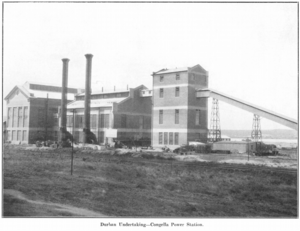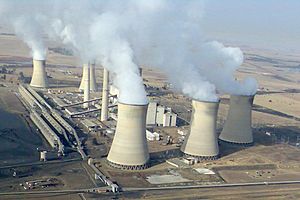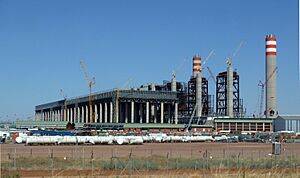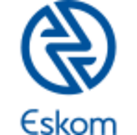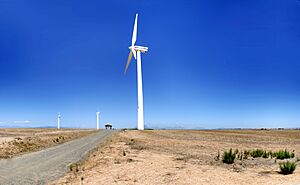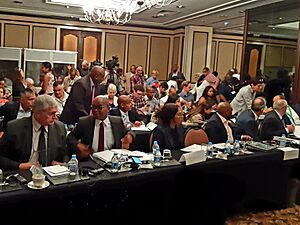Eskom facts for kids
 |
|
| Public utility | |
| Traded as | JSE: BIESKM |
| Industry | Energy |
| Founded | 1 March 1923 |
| Headquarters | Sunninghill, Sandton, South Africa |
|
Key people
|
Mpho Paul Makwana (Chairman) |
| Services | Electricity generation, transmission and distribution |
| Revenue | US$ 13.82 billion |
US$ -1.28 billion |
|
| Total assets | US$52.84 billion |
|
Number of employees
|
|
| Subsidiaries |
List
Amazing Amanzi (Pty) Ltd
EON Solutions Africa (Pty) Ltd |
Eskom Hld SOC Ltd or Eskom (Afrikaans: Elektrisiteitsvoorsieningskommissie) is a South African electricity public utility. Eskom was established in 1923 as the Electricity Supply Commission (ESCOM). Eskom represents South Africa in the Southern African Power Pool. The utility is the largest producer of electricity in Africa, and was among the top utilities in the world in terms of generation capacity and sales. It is the largest of South Africa's state owned enterprises. Eskom operates a number of notable power stations, including Matimba Power Station and Medupi Power Station in Lephalale, Kusile Power Station in Witbank, Kendal Power Station, and Koeberg Nuclear Power Station in the Western Cape Province, the only nuclear power plant in Africa.
The company is divided into Generation, Transmission and Distribution divisions, and together Eskom generates approximately 95% of electricity used in South Africa, amounting to ~45% used in Africa, and emits 42% of South Africa's total greenhouse gas emissions. By releasing 1.6 million tons of sulphur dioxide into the air in 2019, Eskom is also the largest emitter of sulphur dioxide in the power industry in the world. Eskom has periodically implemented rolling blackouts since January 2008, a practice ascribed to basic dereliction of duty by former president Thabo Mbeki. Implementation of new generating capacity during this period was fraught with delays and cost overruns which brought the utility to the brink of bankruptcy. In 2019, it was announced that Eskom was to be split up into three distinct nationally owned entities due to huge debts and poor reliability of supply.
At the 2021 United Nations Climate Change Conference, a deal was announced for developed countries to fund South Africa's transition from coal power to renewable energy. However, employment in the mining sector threatens this transition.
History
Prior to the establishment of Eskom, the provision of electricity was dominated by municipalities and private companies. The city of Kimberley was one of the first users of public electricity when it installed electric streetlights in 1882 to reduce crime at night. This was followed by Cape Town in 1895 with the construction of the Graaff Electric Lighting Works to power 775 street lights.
Eskom was founded by the Electricity Act of 1922 which allowed the South African Electricity Control Board to appoint Hendrik Johannes van der Bijl as chairman. The company changed its name by combining the two acronyms in its previous name (ESCOM and ESKOM) in 1987 to become known as Eskom.
The Electricity Act stated that Eskom could only sell electricity at cost and was exempted from tax with the firm initially raising capital through the issuing of debentures, later issuing state-guaranteed loans instead. The coal-fired Congella Power Station in Durban and Salt River Power Station in Cape Town were the first power stations built by Eskom, both complete in mid-1928.
One of Eskom's first power plants was a coal-fired 128 MW station in Witbank, completed in 1935 to provide power to the mining industry. The plant was built and run in partnership with the privately owned Victoria Falls and Transvaal Power Company, which owned a number of other power plants across the country. Thanks to state support, Eskom was able to buy out the Victoria Falls and Transvaal Power Company in 1948 for £14.5 million (roughly equivalent to £2.55 billion in 2017). Following World War 2, South Africa experienced power shortages that led to Eskom negotiating power saving agreements with the mining industry in June 1948.
First expansion period: 1960-1994
From 1960 to 1990 Eskom increased its installed power production capacity from 4,000 MW to 40,000 MW so as to keep up with rapid economic growth in the 1960s and 70s. During the same period, Eskom established a nationwide 400 kV power network. During this period the company built a number of large standardised coal-fired power plants that could produce power at very low cost due to the large economies of scale. These plants were known colloquially as "six-packs" for the 6 large generator units they were designed to accommodate.
In 1974 the company was instructed to start work on Koeberg nuclear power station to both provide power to Cape Town and help facilitate the South African government's nuclear program.
In 1981 Eskom was involved in one of its first large financial scandals when its Assistant Chief Accountant was caught embezzling R8 million from the company (equivalent to roughly R164.37 million in 2018).
During the 1970s the company controversially sought to increase electrical tariffs to help pay for its large expansion plans. Due to its financial situation, the government appointed Dr. W.J. de Villiers to chair a commission that recommended a number of financial and organisational changes for the company to adopt. This led to the company abandoning its no-profit objective and to raise funds by taking out international loans. The number of Eskom employees was also reduced from 66,000 to 60,000 in the late-1980s.
Post-1994 election period: 1994-2007
Following democratic elections in 1994 and the start of the Mandela government the company changed focus to electrification of previously neglected residential homes and to provide low cost electricity for economic growth. Following the passing of the 1998 Eskom Amendment Act government's powers to influence company policy and investment decisions were greatly expanded. Due to the South African government's attempted privatisation of Eskom in the late 1990s during the administration of President Thabo Mbeki, Eskom requests for budget to build new stations were denied. After leaving the presidency, Mbeki would later state in December 2007 that this was an error, resulting in adverse affects for the South African economy.
Load shedding and second expansion: 2007-present
In February 2006, Eskom announced "load shedding" in the Western Cape province, due to issues experienced by Koeberg Nuclear Power Plant. This continued until June 2006. In January 2008, Eskom introduced load shedding nationally controversially introduced "load shedding"rolling blackouts based on a rotating schedule, in periods where short supply threatened the integrity of the grid. Demand-side management has focused on encouraging consumers to conserve power during peak periods in order to reduce the incidence of load shedding. Following the national power shortage in 2007, Eskom embarked on an aggressive electricity production expansion programme during the administration of President Jacob Zuma. The Zuma administration decided to focus expansion efforts on building additional large scale six-pack coal-fired power plants.
In 2016, Eskom stated it intended to pursue a nuclear solution to the country's energy shortage. According to projections from late 2016, the use of nuclear power would provide over 1000GW of power by 2050. In preparation, the company launched a training program for 100 technicians, engineers and artisans that would certify them as nuclear operators. In January 2018, Eskom's acting chief financial officer stated that the company could not afford a new build, following a 34% drop in interim profits due to declining sales and increasing financing costs. The government stated it would proceed with the plan but more slowly.
In 2017, Eskom was the focus of a major corruption scandal involving the Gupta family and the administration of then President Jacob Zuma.
The National Energy Regulator of South Africa denied an application by Eskom to increase electricity tariffs by a future 19.9% for the financial year 2018/19. The regulator instead granted a 5.2% increase and gave a list of reasons for the refusal to grant higher tariffs that the South African newspaper Business Day stated painted "a picture of inefficiency, inaccurate forecasting and cost overruns" at the power utility. Part of the refusal was the finding that Eskom had 6,000 more employees than needed, costing the company R3.8 billion annually.
In February 2019, shortly after the announcement by government that the company would be broken up, Eskom initiated another round of emergency load shedding. Eskom stated that the 2019 load shedding was initiated due to breakdowns at power stations as well as the depletion of water and diesel resources. Other reasons cited included legacy issues from state capture corruption, coal availability, and that new power plants such as Medupi and Kusile were not yet operational. Corruption during the Zuma administration had been noted as a major factor in the cost overruns and long delays in completing Medupi and Kusile power plants that had a knock-on effect leading to the 2019 power shortages. The power shortage and related troubles at Eskom was blamed as a significant contributing factor to a 3.2% decline in GDP growth in the first quarter of 2019, prompting fears of a recession in 2019. In December 2019, President Ramaphosa, deputy president David Mabuza and Ministers Gwede Mantashe and Pravin Gordhan met with Eskom's board and management to discuss about the energy crises. The president attributed the recent blackouts partly to sabotage at the Tutuka Power Station in Mpumalanga which had caused a loss of 2000 megawatts of electricity, and announced measures to bring an end to load-shedding. Mantashe and Gordhan were tasked with presenting ways to increase electricity capacity to the cabinet, which would include self-generation. Amid the crisis, Jabu Mabuza resigned from his post as chairperson of Eskom's board in January 2020. Between March and July 2020 the power supply was stable due to reduced demand during the COVID-19 lockdown, but on 12 July a new round of level 2 load shedding began due to the breakdown of generating units. During the winter of 2023, the country experienced Stage 6 blackouts, shaving a projected 2% off the country's GDP. During the worst period, power cuts lasted 12 hours a day. The company faces theft of materials for resale, sabotage to force repairs to be made at corruptly inflated prices, and assassination attempts which may be motivated by the attempt to replace coal with renewable sources.
Logos
Eskom's logo has been an integral symbol of the company since its founding. For a brief period in 1986 Eskom had no logo when it was moving away from the company's original logo of stylised letters spelling "ESC" within a circle to the more contemporary version with a blue shield with a stylised lightning bolt in its centre. The 1987 logo was replaced in 2002 with its current logo that replaced the shield with a circle but otherwise kept the logo as it was.
Restructuring efforts
In December 1998, a white paper prepared by the Department of Minerals and Energy recommended that the government restructure Eskom into separate generation and transmission businesses. Although the report predicted that this action would improve power supply and reliability, it was never enacted.
In February 2019, these plans were resurrected during the State of the Nation address. President Ramaphosa announced that the government would be splitting Eskom up into three new state-owned entities focusing on generation, transmission and distribution. This was done so as to better manage the serious operational and financial problems facing the company. By the time of the speech Eskom had a total debt burden of R419 billion (US$30.8 billion) and was entering a death spiral whereby there was not enough revenue to make debt repayments.
In a February 2019 briefing, the Department of Public Enterprises stated that Eskom was "technically insolvent" and would not be able to operate past the next three months if it did not receive additional loans. Finance Minister Tito Mboweni then announced in his 2019 budget speech that government would be providing a R69 billion rand (US$5 billion) bail-out to Eskom over a three-year period so as to stabilise the company's serious financial situation.
Transmission
As result of the restructuring, a transmission entity called the National Transmission Company of South Africa (NTCSA), a wholly-owned subsidiary of Eskom, would be given its own board, by 31 March 2020 in which the transmission legal entity would be responsible for hearing legislative amendments in accordance to government law. This new transmission entity would involve up to 6,000 people that are responsible of setting up thousands of kilometres of "wires" and transmission lines that would ensure electricity from the power stations to where power is needed. As part of the Transmission Development Plan (TDP) for 2020–2029 Eskom has plans to increase its transmission infrastructure by approximately 4,800 km of extra high voltage transmission lines, and over 35,000 MVA of transformer capacity over the next 10 years. This new outline of reconstructing Eskom comes from new regulatory guidelines from the National Energy Regulator of South Africa (NERSA) to publish an annual TDP report.
In July 2023, NERSA approved for the National Transmission Company of South Africa to operate a transmission system in South Africa. In September 2023, NERSA approved the remaining trading and import/export licences.
Job losses
Between 2020 and 2021, two thousand employees lost their jobs at the power utility. 6000 more jobs are reportedly at risk in order for the company to continue operating.
Installed capacity
Subscribers
Eskom – the only electricity utility in the country – has 16,789,974 subscribers in South Africa, comprising about one-third of the population.
Fossil-fuelled power stations
| Power plant | Province | Type | Date commissioned (planned) |
Capacity (MW) (planned) |
Status | Notes |
|---|---|---|---|---|---|---|
| Acacia Power Station | Western Cape | Gas turbine | 1976 | 171 | Operational | |
| Ankerlig Power Station | Western Cape | Gas turbine | 2007 | 1,338 | Operational | |
| Arnot Power Station | Mpumalanga | Coal-fired | 1971-1975 | 2,352 | Operational | |
| Camden Power Station | Mpumalanga | Coal-fired | 1967-1969; 2005-2008 |
1,561 | Operational | |
| Duvha Power Station | Mpumalanga | Coal-fired | 1980-1984 | 3,600 | Operational | |
| Gourikwa Power Station | Western Cape | Gas turbine | 2007 | 746 | Operational | |
| Grootvlei Power Station | Mpumalanga | Coal-fired | 1969-1977; 2008-2011 |
1,180 | Operational | |
| Hendrina Power Station | Mpumalanga | Coal-fired | 1970-1976 | 1,893 | Operational | |
| Kendal Power Station | Mpumalanga | Coal-fired | 1988-1992 | 4,116 | Operational | |
| Komati Power Station | Mpumalanga | Coal-fired | 1961-1966; 2009-2013 |
990 | Operational | |
| Kriel Power Station | Mpumalanga | Coal-fired | 1976-1979 | 3,000 | Operational | |
| Kusile Power Station | Mpumalanga | Coal-fired | (2017–2025) | 3,200 (4,800) | 4/6 units operational | |
| Lethabo Power Station | Free State | Coal-fired | 1985-1990 | 3,708 | Operational | |
| Majuba Power Station | Mpumalanga | Coal-fired | 1996–2001 | 4,110 | Operational | |
| Matimba Power Station | Limpopo | Coal-fired | 1987-1991 | 3,990 | Operational | |
| Matla Power Station | Mpumalanga | Coal-fired | 1979-1983 | 3,600 | Operational | |
| Medupi Power Station | Limpopo | Coal-fired | 2015–2019 | 4,764 | Operational | |
| Port Rex Power Station | Eastern Cape | Gas turbine | 1976 | 171 | Operational | |
| Tutuka Power Station | Mpumalanga | Coal-fired | 1985-1990 | 3,654 | Operational |
Renewable and nuclear power stations
| Power plant | Province | Type | Date commissioned |
Installed capacity (MW) |
Status | Notes |
|---|---|---|---|---|---|---|
| Colley Wobbles Power Station | Eastern Cape | Hydroelectric | 1984 | 42 | Operational | |
| Drakensberg Pumped Storage Scheme | Free State | Hydroelectric | 1981 | 1,000 | Operational | |
| Gariep Dam | Free State-Eastern Cape border | Hydroelectric | 1971 | 360 | Operational | |
| Ingula Pumped Storage Scheme | KwaZulu-Natal | Hydroelectric | 2017 | 1,332 | Operational | |
| Koeberg Power Station | Western Cape | Nuclear | 1984 | 1,860 | Operational | |
| Ncora Dam | Eastern Cape | Hydroelectric | 1972 | 2.1 | Operational | |
| Palmiet Pumped Storage Scheme | Western Cape | Hydroelectric | 1988 | 400 | Operational | |
| Sere Wind Farm | Western Cape | Wind | Jan 2015 | 100 | Operational | |
| Vanderkloof Dam | Northern Cape | Hydroelectric | 1977 | 240 | Operational |
Future projects
Eskom has a number of planned infrastructure projects to further expand electrical production.
- Tubatse Pumped Storage Scheme – 1500MWe
- Wind 500 – 550MWe
- Tasakoolo Wind farm 200 – 200Mwe
Investment in renewables
As of October 2019 Eskom Holdings SOC Ltd issued a tender to introduce 20 three-phase KW inverters and mountains structures. These structures are planned to distribute power to four power plants, and would introduce Eskom into the solar energy market. The African Investment Forum has announced that it has raised over $40.1 billion in investment into developing new infrastructure, related to renewable energies. This is aimed to help distance itself from Eskom coal power plants, and to focus more on wind and solar developments. The African investment forum is backed up by corporate organizations and lenders, private donors, and the African Development Bank.
These new inverters would be align with South Africa's Integrated Resource Plan (IRP).
South Africa's integrated resource plan
The IRP supports a diverse energy mix with policy aimed to help aim to meet the need of South Africa's energy goals. The Integrated Resource Plan supports electrical infrastructure developments with an aim focused on renewable energy sources. These new investments are directed towards more high efficiency, low emission standards with an emphasis on solar technologies in which 6,000 MW of new Solar PV capabilities and 14,400 MW of new wind power technologies. With renewable energies, the IRP plans to increase its investment in hydro-electric power.
Investment in renewables, hydro, wind, solar
With failing power plants and coal not working as a viable solution, progress towards a greener future is in sight for South Africa. In agreement to the Paris Agreement, South Africa needs to reduce its carbon emission and cut-back from being dependent on Coal. There is new US$11 Billion Green-Energy Initiative aimed at the development of solar and wind. This new initiative would allow loans to Eskom and below commercial rates on conditions that it would accelerate its closure of power plants and to start building renewable energy structures. This plan takes the steps in moving away from coal, and investing in alternative methods that better suit their needs for the future.
Other infrastructure
In 2002, Eskom was issued a network operator licence. It embarked on a $100 million project installing fibre optic cables on 10 000 kilometres of its existing power lines for the purpose of real-time monitoring of the electrical network; 80% consists of all-dielectric lashed cabling and 10% All-dielectric self-supporting cabling. It currently has the sixth most ASN prefixes of all registered network operator licensees.
Corporate affairs
In 2011 eight out of ten Eskom board members were controversially sacked by the Zuma administration. From 2015 to 2017 the Zuma administration appointed Ben Ngubane as chairperson of the board. Brian Molefe was appointed by Zuma as Eskom CEO from April 2015 to November 2016. Molefe and Ngubane's tenure was controversial for their involvement with the Gupta family and for allegedly allowing the company to become a vehicle for state capture. Ngubane also controversially attempted to blacklist newspapers perceived as unfriendly to Eskom. During parliament's state capture inquiry in 2017 former Eskom chairperson Zola Tsotsi (2012–2015) testified that Gupta family member Tony Gupta made threats against Tsotsi allegedly stating that Tsotsi will lose his job as he was not 'helping' the Guptas. In December 2016, Matshela Koko, former head of generation for Eskom, was named as acting CEO. He resigned in 2018 after being implicated in awarding contracts to a company linked to his stepdaughter. Koko, along with his wife and stepdaughter, were arrested in October 2022. In early 2018, following the establishment of the Ramaphosa government, multiple members of the Eskom board and executive team were replaced by government due to allegations of corruption and mismanagement.
Phakamani Hadebe was made acting CEO and director of Eskom in May 2018 as part of President Ramaphosa's replacement of the company's executive team. A year into his term as CEO Hadebe resigned citing poor health and the difficult circumstances of the job. His resignation sparked a debate amongst political parties over the difficult state of managing the financially strained state owned company as well as the lack of political cover he was given to deal with labour unions and tackle corruption.
Six months after Hadebe's departure, former Nampak Chief Executive André de Ruyter was appointed CEO of Eskom. De Ruyter's appointment was criticised by the EFF and factions within the ANC who instead wanted a black CEO appointed to the position. De Ruyter resigned in December 2022 after repeated attacks on him by Gwede Mantashe, Minister of Mineral Resources and Energy partly due to de Ruyter's advocacy for replacing coal with renewables as an energy source. News24 reported that he was not given the support needed to succeed in the position. Shortly after the announcement that de Ruyter would be leaving Eskom it was reported that he survived a poisoning attempt after he unknowingly drank a cup of coffee at his office that was laced with cyanide.
Financials
| 2011 | 2012 | 2013 | 2014 | 2015 | 2016 | 2017 | 2018 | 2019 | 2020 | 2021 | |
|---|---|---|---|---|---|---|---|---|---|---|---|
| Revenue (R billion) | 91.45 | 114.8 | 128.9 | 138.3 | 147.7 | 164.2 | 177.1 | 177.4 | 179.8 | 199.5 | 204.3 |
| Operating profit (R billion) | 14.5 | 22.3 | 3.99 | 13.2 | 11.1 | 15.7 | 15.5 | 20.5 | −1.77 | 4.41 | 6.68 |
| Net income (R billion) | 8.36 | 13.2 | 5.18 | 7.09 | 3.62 | 5.15 | 0.88 | −2.33 | −20.7 | −20.8 | −18.9 |
| Total debt (R billion) | 160.3 | 182.6 | 202.9 | 254.8 | 297.4 | 322.7 | 355.3 | 388.7 | 440.6 | 483.7 | 401.8 |
| Employee benefit expenses (R billion) | 16.7 | 20.2 | 23.6 | 25.6 | 25.9 | 29.2 | 33.1 | 29.4 | 33.3 | 33.2 | 32.9 |
| Number of employees | 41,778 | 43,473 | 46,266 | 46,919 | 46,490 | 47,978 | 47,658 | 48,628 | 46,665 | 44,772 | 42,749 |
| Electrical output capacity (GWh) | 237,430 | 237,414 | 232,228 | 231,129 | 226,300 | 238,599 | 220,166 | 221,936 | 218,939 | 214,968 | 201,400 |
In 2018 and 2019 Eskom's negative financial situation became serious as costs started exceeding income and the company started experiencing trouble raising money. For 72 hours between 26 March and 29 March 2019 it was reported that Eskom had run out of funds thereby threatening to negatively impact the broader South African economy. The situation was alleviated once Eskom secured a R3 billion commercial loan which was paid back on 2 April after the Reserve Bank disbursed R5 billion to Eskom through an emergency provision. In July 2019 Eskom announced a loss of R20.7 billion due to the cost of servicing high levels of debt, the increased cost of primary energy and unpaid municipal debts.
Debt
In late 2016, Standard & Poor's Global Ratings downgraded Eskom's credit rating further into subinvestment grade cutting its long-term credit rating to BB – two levels below the investment threshold. By 2017 increasing levels of debt and corruption scandals affecting the company has led investment bank Goldman Sachs to declare Eskom as being the "biggest risk to South Africa’s economy." The company had R413 billion in debt and planned to raise an additional R340 billion (US$26 billion) by 2022 thereby representing eight percent of South Africa's GDP. R218.2 billion of the company's debt consist of government guarantees. Exacerbating the company's financial situation was a recorded R3 billion worth of irregular expenditures in 2017.
On 28 March 2018 Moody's Investors Service downgraded Eskom's credit rating to B2 from B1 stating that it was concerned with "the lack of any tangible financial support for the company in the February state budget".
On 24 November 2020, Moody's further downgraded Eskom's long-term credit rating to Caa1. This places Eskom's credit within the "speculative grade" of investment, with a "very high credit risk".
Due to the company's large size and important role as the region's primary energy producer President Ramaphosa stated that Eskom was "too big to fail" as the reason why government had to continue to fund it despite its serious financial situation.
In February 2023, with debt sitting at R423 billion, the South African government announced that, subject to approval from existing debt holders, it would be providing support worth R254 billion, including interest payments for the following three years and three capital payments of R78-billion in 2023/24, R66 billion in 2024/25 and R40-billion in 2025/26, with the intention to reduce Eskom's overall debt to R300 billion.
Chinese debt
In July 2018 it was announced that Eskom had taken out a R33 billion loan from the Chinese government owned China Development Bank. The loan conditions were controversially not made public with accusations that it was an example of debt-trap diplomacy by China. During the Zondo Commission of Inquiry into state corruption a senior Eskom executive stated that an additional R25 billion loan from the China-based company Huarong Energy Africa was improperly and controversially taken out by Eskom. After the loan had been issued Eskom chairperson Jabu Mabuza stated to the Zondo Commission that Eskom would not be repaying the Huarong loan due to irregularities and corruption involved in the issuing of the loan.
See also
- Cahora Bassa (HVDC)
- Eskom Centre
- XMLVend
- Hendrik van der Bijl – founder and first chairman of ESCOM (Eskom)
- South African energy crisis


